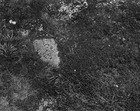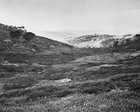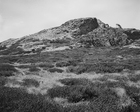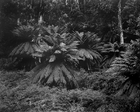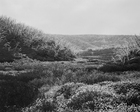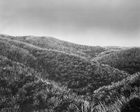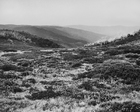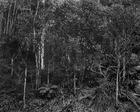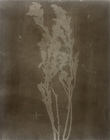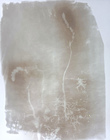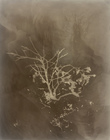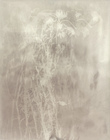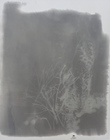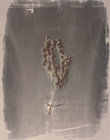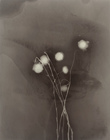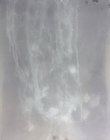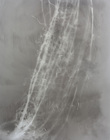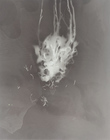Artist text
by Anneke Jaspers
The seven photographs in Amanda Williams’ series Alpine Bogs and Associated Fens (2020) depict the unique ecology of Victoria’s Alpine National Park. Together, they form a noncontinuous panorama that charts a topographic journey from the high plains above the tree line to the moist depths of a valley floor. Williams’ subject is the endangered wetland bogs and fens of this region, which are under threat from the effects of climate change. In an uncanny turn of events, the last of her negatives were exposed as devastating bushfires raged out of frame in the final days of 2019, leaving a smoky haze that permeates several of the images.
In recent years, Williams has made numerous works exploring the unstable nature of photography using experimental techniques. For Alpine Bogs and Associated Fens, her approach was deliberately more orthodox. The photographs were taken on medium-format film, exposed without a tripod during long walks. Their horizon is consistent, the long focus ‘objective.' (1) Likewise, Williams notes that there was ‘no affectation’ in the analogue darkroom process. The large silver gelatin prints simply register these extraordinary landscapes in granular detail, evoking a history of photography as a form of documentary evidence.
The anachronism of Williams’ methods and the vast, majestic scale of her vistas also conjure a more specific photographic genealogy. In the Australian context, landscape photography was used throughout the 19th and 20th centuries to propagate the fantasy of Country as wilderness. As historian Jarrod Hore has observed, photographers such as Nicholas Caire and John Watt Beattie used their imagery to frame nature as ‘beautiful, available and empty.' (2) Their work is inextricable from the project of colonial expansion and its corollary, the dispossession of Australia’s First People. Williams inserts herself into this patriarchal tradition and mythologising process, offering a timestamp of another historical moment.
Consider her choice of site. In settler colonies, national parks are particularly charged locations, which link unresolved issues of sovereignty with the pictorial construction of national identity and increasingly urgent environmentalist agendas. Williams is well versed in this confluence of narratives. (3) Indeed, like the smoke from the bushfires, it haunts the images in Alpine Bogs and Associated Fens. But perhaps what she distils more acutely in this series is the way in which national parks and analogue photography share a troubled logic of preservation. Both seek to fix the material world in time, and yet neither exists in a state of permanent arrest.
Intrigued by this paradox, last summer Williams returned to the Australian Alps in the wake of epic rainfalls that caused dams in the region to spill, leading to catastrophic floods downstream. On her earlier visits, she had held in mind the stereoscopic image Fern trees, circa 1870 by Samuel Clifford: a cipher for the lineage of colonial landscape photography she was seeking to engage. This time, she meditated on the fugitive character of landscapes and photographs, testing new ways to register their inevitable, entropic change over time. In addition to taking documentary negatives of the bogs and fens, Williams made direct prints by burying photographic paper and celluloid film under leaf litter and soil. In the darkroom, she left these abstract, enigmatic traces unfixed so that they will visibly morph as the minerals on their surface are continually exposed to light. In her words, these images embody how ‘the still image is actually a moving image, despite the frozen moment photography supposedly affirms.’ In her mind, they are like bruises: metaphors for a wounded environment.
(1) All quotes attributed to the artist are drawn from conversations with the author in August 2021 and November 2022.
(2) Jarrod Hore, ‘Beautiful, available and empty – how landscape photographers reinvented the colonial project in Australia’, The Conversation, 12 November 2021, retrieved November 2022, https://theconversation.com/friday-essay-beautiful-available-and-empty-how-landscape-photographers-reinvented-the-colonial-project-in-australia-169945.
(3) Williams’ research for Alpine Bogs and Associated Fens included consultation with traditional Aboriginal owners from among the multiple language groups whose Ancestral connections to the area have been disrupted by colonial occupation. On a related tangent, her body of work The Ansel Adams Mural Project (2019–ongoing) responds to Adams’ legendary 1941 commission to document America’s national parks, and calls to mind the earlier role of landscape photography by nascent environmentalists in catalysing the national parks system.











